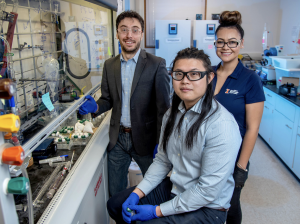
‘Breakthrough’ process boosts plastics recycling by transforming PE into PP
Canadian Plastics
Materials Recycling Research & DevelopmentDeveloped by scientists at University of Illinois Urbana-Champaign, University of California, Santa Barbara, and Dow, the new process can reduce carbon emissions.

Chemical and biomolecular engineering professor Damien Guironnet and graduate students Vanessa DaSilva and Nicholas Wang demonstrated a new scalable process that can upcycle plastics. Photo Credit: Heather Coit/University of Illinois
Working with chemical maker Dow, scientists from the University of Illinois Urbana-Champaign and the University of California, Santa Barbara have developed what’s being described as a breakthrough process to transform the most widely produced plastic – polyethylene (PE) – into the second-most widely produced plastic, polypropylene (PP), which will significantly reduce greenhouse gas emissions (GHG).
The new study published in the Journal of the American Chemical Society announces a series of coupled catalytic reactions that transform PE, which is #2 and #4 plastic that make up 29 per cent of the world’s plastic consumption, into the building block propylene that’s the key ingredient to produce PP, also known as #5 plastic that accounts for close to 25 per cent of the world’s plastic consumption.
This study establishes a proof-of-concept for upcycling PE plastic with more than 95 per cent selectivity into propylene. The researchers have built a reactor that creates a continuous flow of propylene that can be converted into PP easily using current technology, which makes this discovery scalable and rapidly implementable.
The goal is to cut each very long PE molecule many times to obtain many small pieces, which are the propylene molecules. First, a catalyst removes hydrogen from the PE, creating a reactive location on the chain. Next, the chain is split in two at this location using a second catalyst, which caps the ends using ethylene. Finally, a third catalyst moves the reactive site along the PE chain so the process can be repeated. Eventually, all that is left are a large number of propylene molecules.
“Think of cutting a baguette in half, and then cutting precisely-sized pieces off the end of each half – where the speed at which you cut controls the size of each slice,” said Damien Guironnet, a co-lead author and a professor of chemical and biomolecular engineering at Illinois.
“Now that we have established the proof of concept, we can start to improve the efficiency of the process by designing catalysts that are faster and more productive, making it possible to scale up,” said co-lead author Susannah Scott, Distinguished Professor and Mellichamp Chair of Sustainable Catalytic Processing at UC Santa Barbara. “Since our end-product is already compatible with current industry separation processes, better catalysts will make it possible to implement this breakthrough rapidly.”
If you’re wondering why this project matters, here’s the answer: Preliminary analysis suggests that if just 20 per cent of the world’s PE could be recovered and converted via this route, it could represent a potential savings of GHG emissions comparable to taking 3 million cars off the road.
“If we are to upcycle a significant fraction of the over 100 million tons of plastic waste we generate each year, we need solutions that are highly scalable,” Guironnet said. “Our team demonstrated the chemistry in a flow reactor we developed to produce propylene highly selectively and continuously. This is a key advance to address the immense volume of the problem that we are facing.”
Dow researchers were also involved in this work. “Dow is taking a leading role in driving a more circular economy by designing for circularity, building new business models for circular materials, and partnering to end plastic waste,” said Dow senior scientist and co-author Ivan Konstantinov. “As a funder of this project, we are committed to finding new ways to eliminate plastic waste and are encouraged by this approach.”
